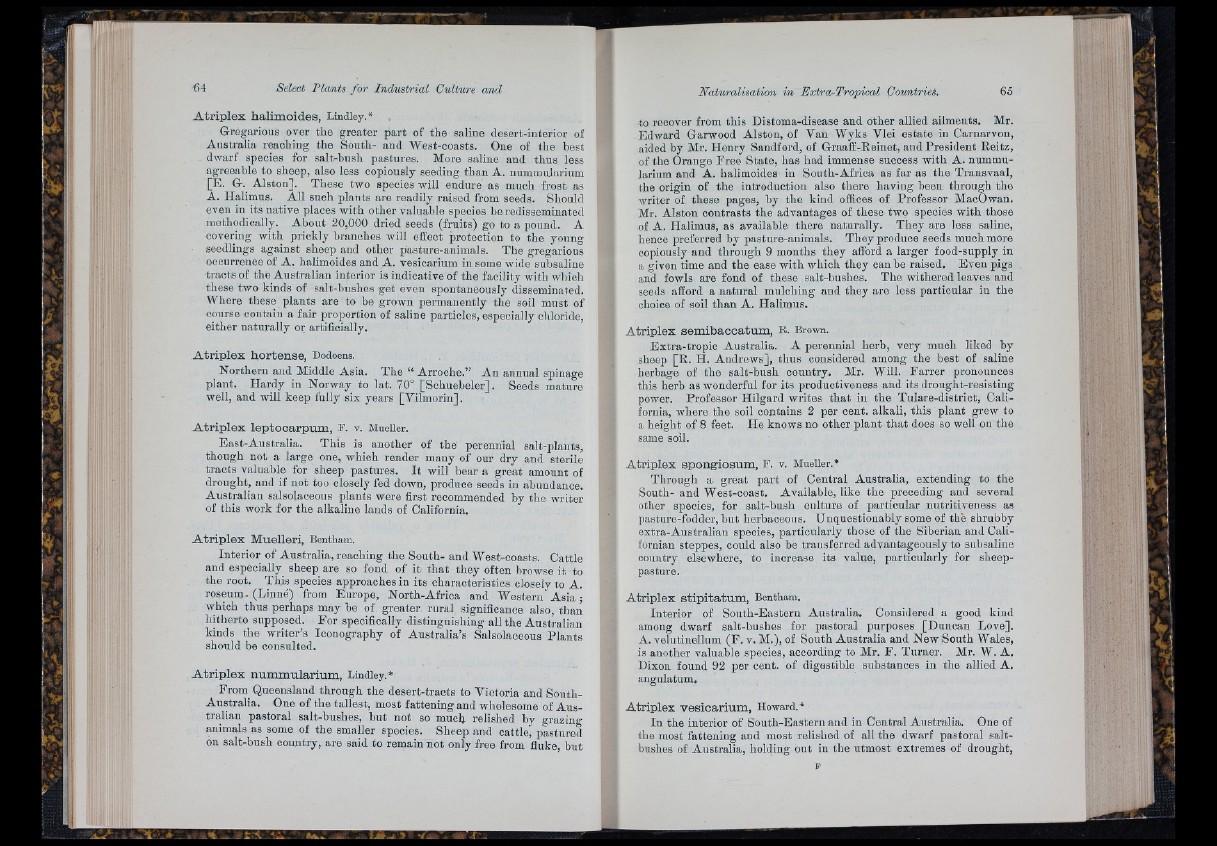
A tr ip le x h a lim o id e s , Lindley.* .
Gregarious over the greater part of the saline desert-interior of
Australia reaching the South- and West-coasts. One of the best
dwarf species for salt-bush pastures. More saline and thus less
agreeable to sheep, also less copiously seeding than A. nummularinm
[E. G. Alston]. These two species will endure as much frost as
A. Halimus. All such plants are readily raised from seeds. Should
even in its native places with other valuable species be redisseminated
methodically. About 20,000 dried seeds (fruits) go to a pound. A
covering with prickly branches will effect protection to the young
seedlings against sheep and other pasture-animals. The gregarious
occurrence of A. halimoides and A. vesicarium in some wide subsaliue
tracts of the Australian interior is indicative of the facility with wliicli
these two kinds of salt-bushes get even spontaneously disseminated.
Where these plants are to be grown permanently the soil must of
course contain a fair proportion of saline particles, especially cldoride,
either naturally or artificially.
A tr ip le x h o rte n s e , Dodoens.
Northern and Middle Asia. The “ Arroche.” An annual spinage
plant. Hardy in Norway to lat. 70° [Schuebeler]. Seeds mature
well, and will keep fully six years [Vilmorin].
A tr ip le x le p to c a rp um , F. v. Mueller.
East-Australia. This is another of the perennial salt-plants,
though not a large one, which render many of our dry and sterile
tracts valuable for sheep pastures. I t will bear a great amount of
drought, and if not too closely fed down, produce seeds in abundance.
Australian salsolaceous plants were first recommended by the writer
of this work for the alkaline lands of California.
A tr ip le x M u e lle ri, Bentham.
Interior of Australia, reaching the South- and West-coasts. Cattle
and especially sheep are so fond of it th a t they often browse it to
the root. This species approaches in its characteristics closely to A.
roseum. (Linné) from Europe, North-Africa and Western A sia ;
which thus perhaps may be of greater rural significance also, than
hitherto supposed. For specifically distinguishing all the Australian
kinds the writer’s Iconography of Australia’s Salsolaceous Plants
should be consulted.
A tr ip le x n um m u la r ium , Lindley.*
From^ Queensland through the desert-tracts to Victoria and South-
Anstralia. One of the tallest, most fattening and wholesome of Australian
pastoral salt-bushes, but not so muci) relished by grazing
animals as some of the smaller species. Sheep and cattle, pastured
on salt-bush country, are said to remain not only free from fluke, but
to recover from this Distoma-disease and other allied ailments. Mr.
Edward Garwood Alston, of Van Wyks Vlei estate in Carnarvon,
aided by Mr. Henry Sandford, of Graafl-Reinet, and President Reitz,
o fth e Orange Free State, has had immense success with A. nummularium
and A. halimoides in South-Africa as far as the Transvaal,
the origin of the introduction also there having been through the
writer of these pages, by the kind offices of Professor MacOwan.
Mr. Alston contrasts the advantages of these two species with those
of A. Halimus, as available there naturally. They are less saline,
hence preferred by pasture-animals. They produce seeds much more
copiously and through 9 months they afford a larger food-supply in
a given time and the ease with which they can be raised. Even pigs
and fowls are fond of these salt-bushes. The withered leaves and
seeds afford a natural mulching and they are less particular in the
choice of soil than A. Halimus.
A trip le x s em ib a o o a tum , B. Brown.
Extra-tropic Australia. A perennial herb, very much liked by
sheep [R. H. Andrews], thus considered among the best of saline
herbage of the salt-bush country. Mr. Will. Farrer pronounces
this herb as wonderful for its productiveness and its drought-resisting
power. Professor Hilgard writes that in the Tulare-district, California,
where the soil contains 2 per cent, alkali, this plant grew to
a height of 8 feet. He knows no other plant th a t does so well on the
same soil.
A trip le x sp o n g io sum , F. v, Mueller.*
Through a great part of Central Australia, extending to the
South- and West-coast. Available, like the preceding aud several
other species, for salt-bush culture of particular nutritiveness as
pasture-fodder, but herbaceous. Unquestionably some of thè shrubby
extra-Australian species, particularly those of the Siberian and Californian
steppes, could also be transferred advantageously to subsaline
country elsewhere, to increase its value, particularly for sheep-
pasture.
A trip le x s tip i ta tum , Bentham.
Interior of South-Eastern Australia. Considered a good kind
among dwarf salt-bushes for pastoral purposes [Duncan Love].
A. velutinellum (F . v. M.), of South Australia and New South Wales,
is another valuable species, according to Mr. F. Turner. Mr. W. A.
Dixon found 92 per cent, of digestible substances in the allied A.
angulatum.
A trip le x v e s ic a rium , Howard.*
In the interior of South-Eastern aud in Central Australia. One of
the most fattening and most relished of all the dwarf pastoral salt-
bushes of Australia, holding out in the utmost extremes of drought.
’ i'
.. I
f y 'V . > ■
f
t ' - L '
f é ' ■ ■
'c 1 ■ '■ '